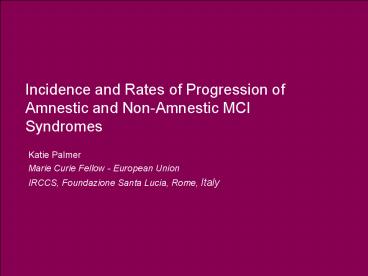Rubrik, Arial Bold 32 pt - PowerPoint PPT Presentation
1 / 20
Title:
Rubrik, Arial Bold 32 pt
Description:
Incidence and Rates of Progression of Amnestic and Non-Amnestic MCI Syndromes ... Polypharmacy: 5 drugs. Relative risk: 3.1 (1.2 8.0) History of psychosis. ... – PowerPoint PPT presentation
Number of Views:45
Avg rating:3.0/5.0
Title: Rubrik, Arial Bold 32 pt
1
Incidence and Rates of Progression of Amnestic
and Non-Amnestic MCI Syndromes
Katie Palmer Marie Curie Fellow - European
Union IRCCS, Foundazione Santa Lucia, Rome, Italy
2
The role of population-based studies
- Large samples
- Long follow-up time
- Identify also cognitively impaired individuals
who do not seek medical attention - Provide a picture of the real-life situation
- Evaluations less thorough than clinical
examinations - Longer follow-up times
- High mortality rates in the elderly may affect
longitudinal estimates - Long-term studies initiated before MCI criteria
were proposed
3
The Kungsholmen Project, Stockholm, Sweden
4
Nine year incidence of MCI and CIND
Caracciolo et al, Neurology 2008
5
Incidence of amnestic MCIPopulation-based studies
- Leila 75 project, Germany
- 3 years (AACD and amnestic MCI)
- 8-77.0 per 1000 person-years
- Paquid Study, France
- 5 years
- 9.9 per 1000 person-years
- Caide, Kupio Study, Finland
- 3 years
- 25.9 per 1000 person-years
- Italian Longitudinal Study on Aging
- 3 years
- 21.5 per 1000 person-years
Busse et al, 2003
Larrieu et al, 2002
Tervo et al, 2004
Solfrizzi et al, 2004
6
Nine year incidence of MCI the affect of
attrition
Caracciolo et al, Neurology 2008
7
Risk factors for incident cognitive impairment
- Risk factors for cognitive Impairment, after
adjustment for future AD development - Hip fracture. Relative risk 2.9 (1.17.8)
- Polypharmacy 5 drugs. Relative risk 3.1
(1.28.0) - History of psychosis. Relative risk 5.0
(1.123.6) - Risk factors for cognitive impairment, that are
related to AD - Depressive symptoms. Relative risk 1.9
(1.13.1)
Monastero et al, Am J Geri Psychiatr 2007
8
Prevalence of MCI per 100 non-demented people in
the general population
Palmer et al, Am J Geri Psychiatr 2008
9
Three year progression from MCI to ADModifed vs
standard criteria
- MCI-Amnestic
MCI-Multidomains
Standard criteria
Modified criteria
Modified criteria
- Standard
- criteria
- Hazard Ratios for progression from MCI to AD,
adjusted for age, sex, education
Palmer et al, Am J Geri Psychiatr 2008
10
Three year progression from MCI to AD
Alzheimers at
3-years RR (95 CI) Normal
functioning on all tests 1.0 Amnestic
MCI 9.3 (2.4-34.7) Single non-memory
MCI 2.4 (0.5-11.3) MCI Multiple domains
impaired 21.9 (9.7-49.5)
- Hazard Ratios for progression from MCI to AD,
adjusted for age, sex, education
Palmer et al, Am J Geri Psychiatr 2008
11
MCI modified criteria Increase prevalence
without diminishing predictivity of AD
- Canadian Study of Health and Ageing
- Instrumental ADL
- Subjective memory complaints
- Leila 75 project, Germany
- Subjective memory complaints
- MoVIES study, USA
- Subjective memory complaint
- Paquid Study, France
- Instrumental ADL
Fisk et al, 2003
Busse et al, 2003
Ganguli et al, 2004
Peres et al, 2006
12
Pooled analysis of amnestic MCI
progressionTemporal trends
- 15 long-term studies on MCI population based
clinical studies - Cumulative conversion rate from MCI to AD 31.4
- Mean annual conversion rate 3.3 (95 CI
3.0-3.6) - -Population studies 2.6
- -Clinical studies 6.7
- Conversion rates from MCI to AD are not linear
Mitchell et al, JNNP 2008
13
Factors affecting MCI progression
Palmer et al, Neurology 2007
14
Factors affecting MCI progression
Neurodegenerative MCI
MCI patients who do not progress to AD
Depression
Depression
Palmer et al, Neurology 2007
15
Possible etiologies of MCI subtypes
International working group on MCI Consensus
Conference Stockholm 2003
Winblad et al, J Internal Med 2003
16
Somatic factors that affect cognition
Global cognition
Episodic memory
Verbal fluency
Other domains
17
Somatic factors that affect cognition
Global cognition
Episodic memory
Verbal fluency
Other domains
18
Risk factors / early markers of AD?
19
ConclusionsMethodological considerations for the
future
- Generally, incidence rate estimates are similar
- - Case definitions / criteria affect incidence
prevalence estimates - - Difficult to estimate affect of mortality
- Single- non-memory deficit MCI common in
population-studies - - Do these patients seek less medical care in
memory clinics? - Amnestic and Multidomain MCI high rate of
progression to dementia - Annual conversion rates from MCI to AD are not
linear - Neuropsychiatric disorders are common in MCI, and
some predict progression to AD - -Differentiating MCIdepression vs Depression
cognitive deficits
20
- COLLABORATORS
- Massimo Musicco Gianfranco Spalletta
- Fulvia di Iulio Carlo Caltagirone
- Italian National Research Council (CNR)
Foundazione Santa Lucia, Italy - Laura Fratiglioni Lars Bäckman
- Bengt Winblad Barbara Caracciolo
- Anna Karin Berger Roberto Monastero Anna
Rita Atti - Aging Research Center, NVS, Karolinska
Institutet, Sweden - Funding acknowledgements
- Marie Curie Intra-European Individual Fellowship
(EU)












![[DOWNLOAD]⚡️PDF✔️ Low Vision Notebook: Bold Lined Paper For Visually Impaired | PowerPoint PPT Presentation](https://s3.amazonaws.com/images.powershow.com/10136189.th0.jpg?_=20240923012)
![[DOWNLOAD]⚡️PDF✔️ Low Vision Notebook: Bold Lined Paper For Visually Impaired | PowerPoint PPT Presentation](https://s3.amazonaws.com/images.powershow.com/10129200.th0.jpg?_=20240911102)
![[PDF]❤️DOWNLOAD⚡️ Low Vision Notebook: Bold Lined Paper For Visually Impaired | PowerPoint PPT Presentation](https://s3.amazonaws.com/images.powershow.com/10136188.th0.jpg?_=20240923011)
![[PDF]❤️DOWNLOAD⚡️ Low Vision Notebook: Bold Lined Paper For Visually Impaired | PowerPoint PPT Presentation](https://s3.amazonaws.com/images.powershow.com/10129199.th0.jpg?_=20240911102)







![[DOWNLOAD]⚡️PDF✔️ Low Vision Notebook: Bold Lined Paper For Visually Impaired | Galaxy (Low Visi PowerPoint PPT Presentation](https://s3.amazonaws.com/images.powershow.com/10131327.th0.jpg?_=20240917064)


![[PDF]❤️DOWNLOAD⚡️ Low Vision Notebook: Bold Lined Paper For Visually Impaired | Rainbow Paint St PowerPoint PPT Presentation](https://s3.amazonaws.com/images.powershow.com/10131326.th0.jpg?_=20240917064)




